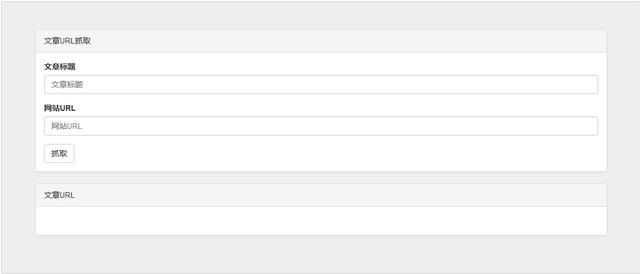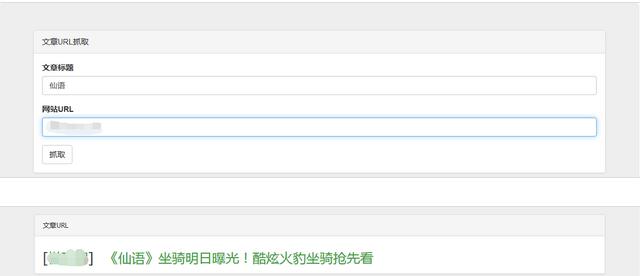 Backend Development
Backend Development
 PHP Tutorial
PHP Tutorial
 PHP HTML JavaScript Css implements simple crawler development_php skills
PHP HTML JavaScript Css implements simple crawler development_php skills
PHP HTML JavaScript Css implements simple crawler development_php skills
To develop a crawler, first you need to know what your crawler is going to be used for. I want to use it to find articles with specific keywords on different websites and get their links so that I can read them quickly.
According to personal habits, I first need to write an interface and clarify my ideas.
1. Go to different websites. Then we need a url input box.
2. Find articles with specific keywords. Then we need an article title input box.
3. Get the article link. Then we need a display container for search results.
<div class="jumbotron" id="mainJumbotron">
<div class="panel panel-default">
<div class="panel-heading">文章URL抓取</div>
<div class="panel-body">
<div class="form-group">
<label for="article_title">文章标题</label>
<input type="text" class="form-control" id="article_title" placeholder="文章标题">
</div>
<div class="form-group">
<label for="website_url">网站URL</label>
<input type="text" class="form-control" id="website_url" placeholder="网站URL">
</div>
<button type="submit" class="btn btn-default">抓取</button>
</div>
</div>
<div class="panel panel-default">
<div class="panel-heading">文章URL</div>
<div class="panel-body">
<h3></h3>
</div>
</div>
</div>
Add the code directly, then add some style adjustments of your own, and the interface is complete:

Then the next step is to implement the function. I use PHP to write it. The first step is to obtain the html code of the website. There are many ways to obtain the html code. I will not introduce them one by one. Curl is used here. Get, pass in the website url and you will get the html code:
private function get_html($url){
$ch = curl_init();
$timeout = 10;
curl_setopt($ch, CURLOPT_URL, $url);
curl_setopt($ch, CURLOPT_RETURNTRANSFER, 1);
curl_setopt($ch, CURLOPT_ENCODING, 'gzip');
curl_setopt($ch, CURLOPT_USERAGENT, 'Mozilla/5.0 (Windows NT 6.1; WOW64) AppleWebKit/537.36 (KHTML, like Gecko) Chrome/34.0.1847.131 Safari/537.36');
curl_setopt($ch, CURLOPT_CONNECTTIMEOUT, $timeout);
$html = curl_exec($ch);
return $html;
}
Although you get the html code, you will soon encounter a problem, that is, the encoding problem, which may make your next step of matching in vain. Here we uniformly convert the obtained html content into utf8 encoding:
$coding = mb_detect_encoding($html); if ($coding != "UTF-8" || !mb_check_encoding($html, "UTF-8")) $html = mb_convert_encoding($html, 'utf-8', 'GBK,UTF-8,ASCII');
Get the html of the website and get the url of the article. Then the next step is to match all a tags under the web page. You need to use regular expressions. After many tests, you finally get a more reliable regular expression. , no matter how complex the structure under the a tag is, as long as it is a tag, it will not be missed: (the most critical step)
$pattern = '|<a[^>]*>(.*)</a>|isU'; preg_match_all($pattern, $html, $matches);
The matching result is in $matches, which is probably a multi-dimensional group like this:
array(2) {
[0]=>
array(*) {
[0]=>
string(*) "完整的a标签"
.
.
.
}
[1]=>
array(*) {
[0]=>
string(*) "与上面下标相对应的a标签中的内容"
}
}
As long as you can get this data, everything else is completely operable. You can traverse this element group, find the a tag you want, and then get the corresponding attributes of the a tag. You can do whatever you want. Here is a class recommended , making it easier for you to operate a tag:
$dom = new DOMDocument();
@$dom->loadHTML($a);//$a是上面得到的一些a标签
$url = new DOMXPath($dom);
$hrefs = $url->evaluate('//a');
for ($i = 0; $i < $hrefs->length; $i++) {
$href = $hrefs->item($i);
$url = $href->getAttribute('href'); //这里获取a标签的href属性
}
Of course, this is just one way. You can also use regular expressions to match the information you want and play new tricks with the data.
Get and match the results you want. The next step is of course to send them back to the front end to display them. Write the interface, then use js to get the data on the front end, and use jquery to dynamically add the content and display it:
var website_url = '你的接口地址';
$.getJSON(website_url,function(data){
if(data){
if(data.text == ''){
$('#article_url').html('<div><p>暂无该文章链接</p></div>');
return;
}
var string = '';
var list = data.text;
for (var j in list) {
var content = list[j].url_content;
for (var i in content) {
if (content[i].title != '') {
string += '<div class="item">' +
'<em>[<a href="http://' + list[j].website.web_url + '" target="_blank">' + list[j].website.web_name + '</a>]</em>' +
'<a href=" ' + content[i].url + '" target="_blank" class="web_url">' + content[i].title + '</a>' +
'</div>';
}
}
}
$('#article_url').html(string);
});
The final rendering:

The above is the entire content of this article, I hope it will be helpful to everyone’s study.

Hot AI Tools

Undresser.AI Undress
AI-powered app for creating realistic nude photos

AI Clothes Remover
Online AI tool for removing clothes from photos.

Undress AI Tool
Undress images for free

Clothoff.io
AI clothes remover

Video Face Swap
Swap faces in any video effortlessly with our completely free AI face swap tool!

Hot Article

Hot Tools

Notepad++7.3.1
Easy-to-use and free code editor

SublimeText3 Chinese version
Chinese version, very easy to use

Zend Studio 13.0.1
Powerful PHP integrated development environment

Dreamweaver CS6
Visual web development tools

SublimeText3 Mac version
God-level code editing software (SublimeText3)

Hot Topics
 1393
1393
 52
52
 1207
1207
 24
24
 PHP 8.4 Installation and Upgrade guide for Ubuntu and Debian
Dec 24, 2024 pm 04:42 PM
PHP 8.4 Installation and Upgrade guide for Ubuntu and Debian
Dec 24, 2024 pm 04:42 PM
PHP 8.4 brings several new features, security improvements, and performance improvements with healthy amounts of feature deprecations and removals. This guide explains how to install PHP 8.4 or upgrade to PHP 8.4 on Ubuntu, Debian, or their derivati
 7 PHP Functions I Regret I Didn't Know Before
Nov 13, 2024 am 09:42 AM
7 PHP Functions I Regret I Didn't Know Before
Nov 13, 2024 am 09:42 AM
If you are an experienced PHP developer, you might have the feeling that you’ve been there and done that already.You have developed a significant number of applications, debugged millions of lines of code, and tweaked a bunch of scripts to achieve op
 How To Set Up Visual Studio Code (VS Code) for PHP Development
Dec 20, 2024 am 11:31 AM
How To Set Up Visual Studio Code (VS Code) for PHP Development
Dec 20, 2024 am 11:31 AM
Visual Studio Code, also known as VS Code, is a free source code editor — or integrated development environment (IDE) — available for all major operating systems. With a large collection of extensions for many programming languages, VS Code can be c
 Explain JSON Web Tokens (JWT) and their use case in PHP APIs.
Apr 05, 2025 am 12:04 AM
Explain JSON Web Tokens (JWT) and their use case in PHP APIs.
Apr 05, 2025 am 12:04 AM
JWT is an open standard based on JSON, used to securely transmit information between parties, mainly for identity authentication and information exchange. 1. JWT consists of three parts: Header, Payload and Signature. 2. The working principle of JWT includes three steps: generating JWT, verifying JWT and parsing Payload. 3. When using JWT for authentication in PHP, JWT can be generated and verified, and user role and permission information can be included in advanced usage. 4. Common errors include signature verification failure, token expiration, and payload oversized. Debugging skills include using debugging tools and logging. 5. Performance optimization and best practices include using appropriate signature algorithms, setting validity periods reasonably,
 How do you parse and process HTML/XML in PHP?
Feb 07, 2025 am 11:57 AM
How do you parse and process HTML/XML in PHP?
Feb 07, 2025 am 11:57 AM
This tutorial demonstrates how to efficiently process XML documents using PHP. XML (eXtensible Markup Language) is a versatile text-based markup language designed for both human readability and machine parsing. It's commonly used for data storage an
 PHP Program to Count Vowels in a String
Feb 07, 2025 pm 12:12 PM
PHP Program to Count Vowels in a String
Feb 07, 2025 pm 12:12 PM
A string is a sequence of characters, including letters, numbers, and symbols. This tutorial will learn how to calculate the number of vowels in a given string in PHP using different methods. The vowels in English are a, e, i, o, u, and they can be uppercase or lowercase. What is a vowel? Vowels are alphabetic characters that represent a specific pronunciation. There are five vowels in English, including uppercase and lowercase: a, e, i, o, u Example 1 Input: String = "Tutorialspoint" Output: 6 explain The vowels in the string "Tutorialspoint" are u, o, i, a, o, i. There are 6 yuan in total
 Explain late static binding in PHP (static::).
Apr 03, 2025 am 12:04 AM
Explain late static binding in PHP (static::).
Apr 03, 2025 am 12:04 AM
Static binding (static::) implements late static binding (LSB) in PHP, allowing calling classes to be referenced in static contexts rather than defining classes. 1) The parsing process is performed at runtime, 2) Look up the call class in the inheritance relationship, 3) It may bring performance overhead.
 What are PHP magic methods (__construct, __destruct, __call, __get, __set, etc.) and provide use cases?
Apr 03, 2025 am 12:03 AM
What are PHP magic methods (__construct, __destruct, __call, __get, __set, etc.) and provide use cases?
Apr 03, 2025 am 12:03 AM
What are the magic methods of PHP? PHP's magic methods include: 1.\_\_construct, used to initialize objects; 2.\_\_destruct, used to clean up resources; 3.\_\_call, handle non-existent method calls; 4.\_\_get, implement dynamic attribute access; 5.\_\_set, implement dynamic attribute settings. These methods are automatically called in certain situations, improving code flexibility and efficiency.



